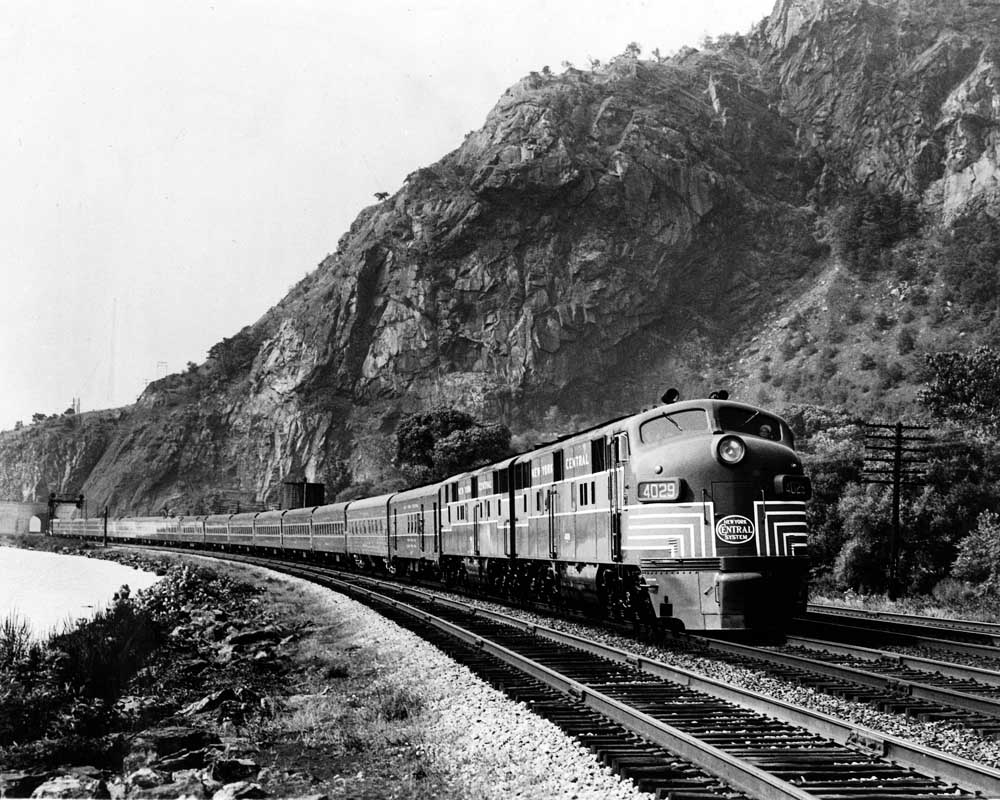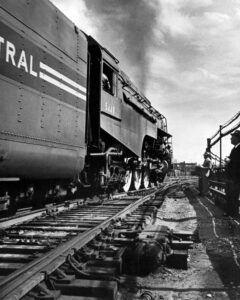New York Central’s 20th Century Limited was dubbed “The Greatest Train Ever Made.”

In the first half of the 20th century, New York and Chicago were the two largest, most dynamic cities in the U.S. and titans of commerce. Big business demanded in-person company meetings, thus the need for fast travel between New York and Chicago — at night, of course, so one could sleep easy while traveling. Business executives wouldn’t dream of doing this trip by coach; they wanted — and could afford — style and posh sleeping accommodations, not to mention exemplary lounge and dining facilities and even a barber shop, shower, and maid service.
The New York Central and rival Pennsylvania Railroad were well aware of high-end clientele, and early in the 20th century inaugurated the Broadway Limited (originally as the Pennsylvania Special) and 20th Century Limited — high-end, high-speed trains aimed directly at the business/wealth market. Periodically, the two railroads upgraded their two premier trains — which, by the way, through agreement, had the same endpoint departure/arrival schedules and 16½-hour running times.
The final re-equipping of these two “starliners” was in 1948 when railroads were enjoying a postwar euphoria that surely signaled a boom in future rail passenger travel. Certainly, there were differences between the new 1948 trains. Each railroad had two trainsets for these iconic trains that “turned” at their endpoints to make start the return trip later the same day. Although the 1948 Broadway featured brand-new rolling stock overall, Pennsylvania chose to save money by upgrading certain older cars for the train. The Central’s 20th Century Limited train consists were all-new, stem to stern, concluding with their distinct, high-windowed observation-lounge cars. Dining car china was marked with the train’s name. As with the 1938 re-equipping of the Century, the 1948 version was wrapped in Art Deco design, inside and out. Pennsy’s 1948 Broadway maintained its colorful Tuscan red cloaking and concluded each consist with a relatively conventional square-end Pullman-Standard observation car.

Both trains catered to magnates and movie stars, with the Century itself treated as a star — which it was. The 1948 Broadway Limited represented “old money” while the 1948 Century meant “new money”— which is why I consider the 1948 Century to be particularly significant, unfortunately, in a bad way. Old money meant staunch, conservative, business-as-is while the new money of the postwar period would mean jet airliners, interstate highways, and luxury automobiles. Sure enough, the Century saw alarming downgrades as the 1950s marched on, including the addition of coaches and budget sleepers. It was no longer an all-Pullman train while the Broadway maintained all-sleeper status into the late 1960s.
Most important, the Century’s alarming decline was most significant in the fact that it signaled the end of overnight, fast, point-to-point, limited-stop through service between Chicago and New York City. The Century — and to a degree the Broadway — never aimed for these trains to cater to travel between, say, New York and Cleveland (New York Central) or Pittsburgh (Pennsylvania). In fact, the Century didn’t even stop at Cleveland Union Terminal; rather, it used the lakeside freight main to make a fast servicing stop in the middle of the night (coincidentally, this routing is currently used by Amtrak’s Lake Shore Limited and the present day Amtrak depot). Amtrak will underscore that relatively few passengers today ride the Lake Shore Limited, Capitol Limited, and Cardinal all the way through from end to end.
I was in high school early in 1967 when I learned that the 20th Century Limited was doomed. Though only 18 years old, the announcements made a strong impression on me, and I did a Century poster in one of my art classes. I was not in position to photograph the last runs (the westbound train was some nine hours late owing to a freight derailment), but at least relieved that I was able to photograph the famous liner on a couple of occasions.
The Central saw the writing on the departure board early on, and by 1968 had restructured much of its passenger network into a series of corridors. Central knew that corridor-type service might be the way of the future, and essentially that has been the case.
The irony is that the Broadway Limited was the survivor, not only to the end of Pennsylvania in 1968 when Penn Central was born, but all the way into Amtrak until that carrier tortured its version of the Broadway to death in 1995.
But that’s another story.
Check out Trains magazine’s feature-length documentary on the 20th Century Limited, available at www.kalmbachhobbystore.com.














A further correction: In the streamliner (1937-end) era both the Century and the Bway maintained a 16 hour timing westbound. Eastbound this dropped to 15 1/2 hours in the post WWII era, but even the four track NYC/PRR mainlines could not reliably maintain this and for the later 1950s and 60s 16 hours was the norm in both directions–for both trains–until December, 1967.
Post 1967 the Bway assumed the times of the former General and was switched enroute at Harrisburg to absorb thru DC coaches and sleepers and running time grew to 17 hours +/- . The Bway remained all-Pullman until combined with the General. The consolidated train held the pride of the then Penn Central New York-Chicago service right to Amtrak day and kept a more than respectable consist with full diner (usually a twin unit set) and full lounge car right into the Amtrak era.
The Century lost its name and became a eastern version of a “City of Everywhere”, leaving New York with through cars for Chicago via both Cleveland and after a split at Buffalo for Chicago via Detroit. It also picked up thru coaches/sleeper(s) from Boston for Chicago at Albany. With all this switching the train also took 17 hours +/-. Although unnamed after the end of the Century in December, 1967 this many faceted train still sported a full diner and lounge car on the main stem via Cleveland and initially at least a diner-lounge on the Detroit side. By the end in 1971 this Buffalo-Detroit-Chicago side was down to a Food Bar coach and on at least one trip I took on the Cleveland side in the winter of 1970/71 a diner-lounge car sufficed. Boston-Albany initially also rated a diner-lounge, which also was gone to “snacks only” land before Amtrak Day on May 1, 1971.
The 1938 cars had prewar bedrooms and compartments whose toilets were not in enclosed annexes. As such, they were inferior to all of NYC’s postwar sleeping cars. They cascaded to lesser trains.
The Century’s 1938 Island cars were rebuilt in 1946 to have 4 Double Bedrooms, Buffet-Lounge-Obs. With this floorplan, they served as the Century’s primary Obs cars until 1948, when the Creek cars arrived with 5 DB-Buffet-Lounge-Obs. 2 of the prewar Island cars went to NYC 67-68 The Commodore Vanderbilt.
I rode No. 26 in 1966, high standards still maintained especially in the dining car, and the train was 30 minutes early at Harmon.
That said, in the article on page 73 “20th Century Limited Fact File,” the first bullet gives the train numbers as 26-27; in my experience it was always 25-26.
The cars were cascaded down to other trains such as the “Commador Vanderbilt”’ and some other trains. As ridership declined some cars were sold to other railroads.
Mike-Nice article. What did New York Central do with the 1938 train sets when they re-equipped the train just 10 years later in 1948?The older equipment must have still been in relativity excellent condition I would think.Thank you,Don Shappelle,Wilkes Barre,Pa.